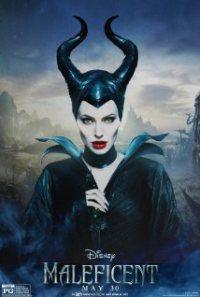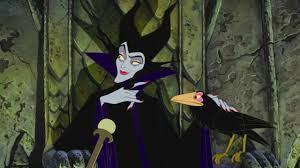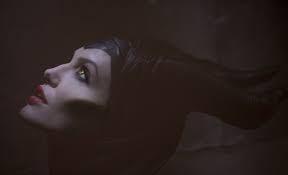
Maleficent promotional poster
Disney’s newest feature, starring Angelina Jolie in the title role, is Maleficent. It’s unlikely this has escaped your attention. The internet has been abuzz with news of the project since before production began, with early photographs of Jolie on set released to the Daily Mail in June 2012 fueling the fire. The character has captured our imaginations. Maleficent t-shirts, posters and Barbie-esque dolls, an addictive app: the Disney Marketing Machine is at peak output, with merchandise not just on shops but out in the wild too. People are buying Maleficent plush toys (though I can’t think of a character less suited to such a medium), jewelry and nail polish. MAC has a Maleficent make up collection (and did I mention it was my birthday soon?). She’s everywhere. And we’re lapping it up.
Sleeping beauty has a 400 year plus history. It feels like Maleficent has always been a part of that. In fact, she’s less than 60 years old.
The oldest known variant* of the Sleeping Beauty story is ‘Sole, Luna, e Talia’ (Sun, Moon and Talia). Written byGiambattista Basile in 1634, it tells the tale of Talia, a baby princess prophesied by astrologers to be grievously imperilled by a splinter of flax at some point in her life. Though her step-mother does plan to cook and eat her, which is probably worse, there is no wicked woman to endanger the princess.
The beginnings of Maleficent as a character can be found in ‘La Belle au bois dormant’ (from Perreault’s 1697 collection Histoires ou contes du temps passé). Here a nameless wicked fairy godmother curses the young princess to prick her finger on a spindle and in Grimm’s ‘Little Briar Rose’ (from Kinder- und Hausmärchen [1812]) it is the same. Grimm’s version of the tale is much gentler than Perrault and Baile’s efforts, ending with the kiss that awakes the princess from her sleep and cutting out the rape, childbirth, ogres and cannibalism.
Most versions produced between 1812 and today follow Grimm’s sanitized version of the story or bypass the wicked fairy completely. Notably Andrew Lang’s ‘The Sleeping Beauty in the Wood’ (in The Blue Fairy Book [1889]) sticks close to Basile’s version. Tchaikovsky’s 1888 ballet is based on Perrault.
When Disney brought their version of Sleeping Beauty in 1959 the gave the antagonist a name. She was Maleficent. It’s a great name for a baddie. The word has a meaning all of its own, of course, but its conjouring of the word ‘magnificent’ together with an inexplicably feminine quality make for an evocative moniker.

1955 Maleficent
Here is a Maleficent that we can really get carried away with. Clad in swathes black and with a pale gray/green tint to her skin, she is tall and extremely slender. Her frond-like fingers and sharp chin mirror the creepy horned hood and spiked collar. Her voice (provided byEleanor Audley who also served as Maleficent’s physical model) is like dark honeyed silk.
This antagonist is not a godmother to the child she curses**, but a trigger-happy, jealous, evil sorceresses who over-reacts to an insulting comment by attacking a newborn baby who definitely wasn’t responsible and then, when her curse is realised, sabotaging anyone trying to rescue the girl. She’s accompanied by a raven, longtime indicator of malevolence and harbinger of death, a pair of magnificent dragons and a troupe of, er, warthogs that bend to her will. Her magic is visually arresting. Green, the color of so many bubbling cauldrons, is associated with nature but also with immortality, and is considered by many to be the most unlucky of all colours. No surprise then that when Maleficent casts her spells the color features heavily, her castle walls reflect a greenish hue and her gray skin is tinted with just a hint of green.
Physically, this newest iteration of Maleficent mirrors her animated predecessor closely. The iconic head-gear remains, as does the raven. She’s visually identified with her predecessor to, through the green miasma that she produces, but we can be certain that the live action Maleficent will be much sexier than her animated counterpart and significantly more morally ambiguous.
While we can’t speak much to her character yet – the film is released on June 28 in the UK) he is clearly identified as a part of the tradition of wicked witches in storytelling. The movies trailer tells us that we will see the villain humanised. We will see Maleficent driven to revenge by deep betrayal and forced to fight to protect her home.

promo image of Angelina Jolie as Maleficent
… Which sounds like we’re about to be asked to forgive someone for putting a death curse on a newborn baby. There is likely much to be said about these apologetic delvings into the psyches of wicked women (Im thinking here of Wicked, Gregory Maguire’s 1995 revisionist Oz novel as well as Jane Yollen’s ">" target="_blank">Curse of the Thirteenth Fey which recasts the wicked fairy as an erudite teenager named Gorse), and our resistance to accepting female figures as simply evil, but that is a job for more learned a feminist than me.
We have received Maleficent so readily in to the cannon of wicked women not just in Disney but in wider culture too because she’s a new spin on an old character. She’s an archetype. We recognize her instantly not just as who she is but as what she represents.
The wicked witch has many names. She is a hag, a harridan, a gorgon. She is beautiful (and therefore evil) or she is ugly (and therefore evil). She is everything we as a society fear about feminine power and learning. Cassell’s Dictionary of Superstition describes her as “bent upon evil and deriving pleasure from inflicting pain and misfortune upon others in the name of her diabolical master”. The wicked witch is, as Jung would have it, a shadow archetype, chaotic, wild and potentially dangerous. She is the things we do not allow ourselves to do. She unabashedly breaks taboos.
As psychologist Clarissa Pinkola Estés reminds us in Women Who Run With the Wolves, Sleeping Beauty is a tale of exile and exclusion. The wicked fairy – the seventh, thirteenth or fourth fairy, depending on which narrative you chose – casts her spell on the baby princess because she is excluded from the celebrations surrounding her birth. In this we can recognize one of our own fears. To be rejected is hurtful. It leaves our social position tenuous and our relationships strained. Maleficent plays out our secret fantasy of revenge. Her vengeance is disproportionate but at least it’s poetic. She exludes the King and Queen from the life of their longed for child, she denys the child the privilege of growing up in the royal family.
These all sound like unpleasant things to be – vengeful, sadistic, chaotic, antisocial. But there is a flip side. Maleficent is unrestrained, joyous and pleasure-seeking. She’s clever and she knows how to best apply her skills. She’s impulsive. Perhaps she is even sexual.
Maleficent is all the things we do not allow ourselves to be. Cruel, impulsive, reactionary. She is the id uncontrolled. We can condemn her, but we like her because she acts outside of the rules of society and, critically, the consequences of her doing so are minimal.
We are told that we ought to want to be the princess, but there in the shadow lurks something much more seductive.
————————————————————————————-
* There is, in fact, an even earlier story from France called ‘Perceforest’ which shares many details with Sleeping Beauty. Critically, the sleeping part is missing from the story, so I have chosen to exclude it.
** Authors have missed a trick with the evil fairy godmother charater. The only other one I can think of is Terry Pratchett’s Lily Weather Wax. If you know of another, please let me know.
